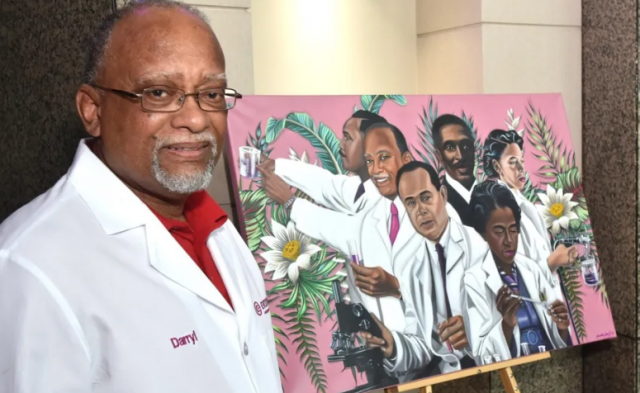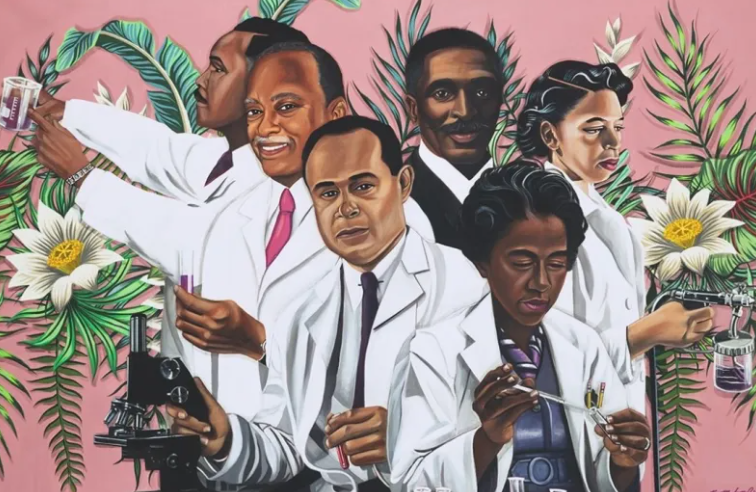
By Solomon Crenshaw Jr.
Alabama News Center
Darryl Love’s passion for science grew partly from his childhood taste in movies. The resident of Fairfield’s Fair Oaks community gravitated to Frankenstein movies and “The Fly.”
“I kind of wanted to be like that guy just in his own little world, mixing up stuff and doing whatever he wanted to,” said Love, senior research and development scientist with Evonik Birmingham Laboratories, a specialty chemicals company. “I didn’t want to end up with my head on a fly. The way those guys operated was kind of the way I wanted to do things.”
Throughout his 47-year career, Love lived the life that he had embraced on the silver screen. But the career chemist was no mad scientist diabolically trying to take over the world. Instead, his work helped to positively change the worlds of countless men and women.
A portrait will adorn a wall in the Evonik building near Birmingham’s Red Mountain Park. The work of New Orleans-based artist Kenneth Scott Jr. titled “Black Resilience – Innovation in the Midst of Resistance” pays tribute to trailblazers like Marie Maynard Daly, the first African American woman to earn a Ph.D. in chemistry.
The painting is a veritable Mount Rushmore of Blacks in science, with Daly joined by Percy Julian, Charles Drew, George Washington Carver and Alma Hayden.
And Evonik’s Darryl Love, the childhood science fiction movie fan who wound up playing the real-life role of a chemist who changed lives. He retires from Evonik at the end of June after having been inspired by Julian and Carver.
In February, during the celebration of Black History Month, Evonik’s employee resource group BUILD – Blacks United in Leadership & Development – chose to honor revered employees and support Black artists and businesses in the community.
“BUILD wanted to highlight black scientists within the company and Black excellence,” said BUILD co-chair Tracy Cheavious, who led the project. “There aren’t many platforms that celebrate Black scientists. We really wanted to take the opportunity to honor our own and find a way to do this and support our Black history theme this year, which is Black resilience.
“The inclusion of one of our own legends in the painting was dear to our hearts,” she said.
The painting will be permanently displayed at Evonik’s Birmingham site after touring several Evonik locations across North America. The portrait’s tour will conclude and coincide with Love’s retirement in June.
Love grew up in the Mississippi Delta region with his family eventually settling in Indianola, Mississippi. His parents were college educated, his father being a math teacher with a bit of science in his background.

A Different Course
As a freshman at Gentry High School, Darryl Love was more interested in physics than chemistry. That interest persisted through his 12th-grade year. But fate put him on – and in – a different course.
“I ended up wanting to take physics as a senior in high school, but only one other person wanted to take physics,” Love recalled. “They put us in chemistry class. I think that chemistry teacher (Otis Anthony) did a lot to make me feel comfortable and start to enjoy chemistry.”
Love wound up getting his bachelor’s degree in chemistry from New Orleans’ Dillard University. He did additional study at UAB.
“I think I went to college still thinking I may major in physics but ended up changing to chemistry,” said the 69-year-old, who worked 29 years at Birmingham’s Southern Research. His group there spun off to become Brookwood Pharmaceuticals, which was sold to become SurModics Pharmaceuticals in 2007 and was sold in 2011 to yield Evonik Birmingham Laboratories.
Love’s career has dealt with controlled release technology, which includes microencapsulation.
“It’s the development of products and medicines that maybe you take on a daily basis,” he said. “We turn it into a formulation where you take an injection maybe once a month, once every three months, once every six months. That’s what my career has been in.
“A lot of the early work was on birth control formulations,” the career chemist said. “Later on, some of the ones that have really become more noted are for the treatment of prostate cancer, as well as some other cancers. I worked on some formulations for diabetes and depression. All of those things did play a part and still play a great part in my thinking on what we do and how it can benefit people.”
Love said being honored in a portrait that will be displayed beyond his career is humbling.
“It’s hard to keep my head from exploding,” he said. “Percy Julian spoke to my chemistry class in college. When he spoke, I had no idea who he was. I didn’t know until afterward. I don’t even know how to express how honoring it is to be on a painting with those individuals.”
Cheavious, business development manager at Evonik, said while Love’s career is coming to an end, the portrait honoring him will make an impact for years to come.
“It not only shows that legends have lived and come before us and created these amazing discoveries, but we have people here today that are also contributing and are a part of what Black excellence looks like in the scientific field,” she said. “I think that seeing that creates a sense of pride. It shows that in spite of everything that’s going on in the current climate … you have to be resilient, and it can be done.”




